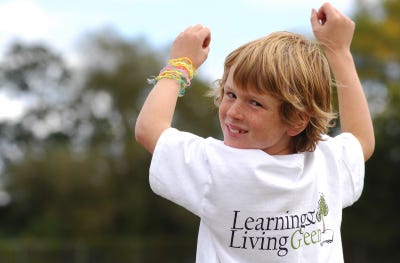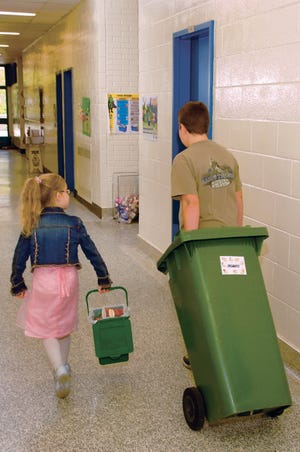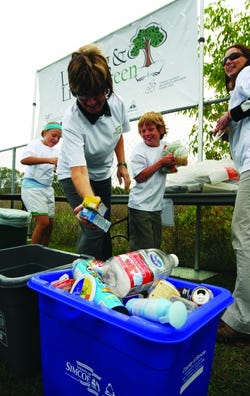Green Grades: Innovative School Recycling Outreach in Ontario
Simcoe County, Ontario, implements a comprehensive recycling education program for kids while maximizing diversion at more than 100 schools.
November 15, 2011
By Willma Bureau, Contract & Collections Supervisor, The County of Simcoe
Simcoe County in central Ontario wants to increase its waste diversion from 58 percent to 71 percent in 10 years. A big reason was necessity — the county has very limited waste disposal capacity remaining. So Simcoe went to school on the problem.
In September 2010 the county, in partnership with five local school boards, implemented a program called Learning & Living Green, which collects recyclable and organic materials at more than 100 schools.
The program is unique among municipalities in Ontario. Few provide collection of recyclables from schools; fewer still provide collection of organics from schools.
 Simcoe County assumed waste management responsibility for the 16 local municipalities in 1990. Since then, the county has established a number of progressive programs that have significantly increased waste diversion, including standardizing recycling services, expanding the blue box program, placing restrictions on curbside garbage collection and implementing a green bin program to collect source-separated organics from approximately 127,000 households.
Simcoe County assumed waste management responsibility for the 16 local municipalities in 1990. Since then, the county has established a number of progressive programs that have significantly increased waste diversion, including standardizing recycling services, expanding the blue box program, placing restrictions on curbside garbage collection and implementing a green bin program to collect source-separated organics from approximately 127,000 households.
The county is experiencing significant population growth, and as a result, increased demand for municipal services such as waste management. Achieving high waste diversion rates is imperative to extending the lifespan of the county’s disposal facilities. The Learning & Living Green program is part of the proposed solution to that problem.
School Supplies
Partnership agreements were developed that outlined the roles and responsibilities of the parties. The county and the local school boards share the cost for outdoor collection containers and annual operating costs 50/50. The county provides capital equipment in the form of a front-loader collection truck, all indoor collection containers and promotion and educational support. The county also received partial funding for the project from the Continuous Improvement Fund (CIF). CIF is mandated to help Ontario municipalities undertake best practice initiatives to improve the effectiveness and efficiency of blue box recycling programs. CIF supported the Learning & Living Green program through $86,500 in funding to partially offset costs related to the eight-yard front-loader recycling containers utilized in the program. That paid for approximately half of the eight-yard front-loader recycling containers, while the county and the school boards split the other half.
The Learning & Living Green program targets school-aged children, as they have significant influence upon adult behavior with respect to environmental initiatives. The program allows schools to divert the same types of blue box materials that are collected in Simcoe County’s curbside residential service. This consistency is vital, as children become more aware of what is recyclable and compostable in the school setting and can then participate more fully in waste diversion programs at home.
“We recognize that children play a significant role in influencing adult behavior with respect to environmental initiatives,” says Rob McCullough, director of solid waste management for Simcoe County. “Establishment of early recycling behaviors and reinforcement of emerging positive patterns among residents is vital to achieving the county’s high waste diversion targets.”
Further, it is hoped that the children will have a positive influence on the adults in their families with regard to residential waste management programs.
The program was branded Learning & Living Green because it aims to teach children to generate less waste and divert as much waste as possible, in the hope that they will take that information home and use it throughout their lives.
The program has resulted in waste diversion increasing by approximately 70 percent as compared with the previous school year, when significantly fewer recyclables were accepted and there was no organics collection.
More than 580 tons of recyclables and organics were collected during the 2010/2011 school year, which equals more than 100 garbage truck loads of material diverted from the landfill.
The Learning & Living Green program is monitored through surveys, tonnage analysis and comprehensive waste audits completed by the county. These waste audits indicated that the schools achieved an 89 percent recycling capture rate and had only a 2.52 percent recycling contamination rate. The schools also achieved a 79 percent organics capture rate and had an almost non-existent organics contamination rate of 0.06 percent. This would indicate that the students and faculty have an excellent understanding of what materials are acceptable and not acceptable in the county’s recycling and organics programs.
Additionally, surveys were conducted of students and school staff in order to determine the environmental and social impacts of the Learning & Living Green program. Survey results indicated that:
60 percent of children assist parents with recyclables/organics sorting and preparation for collection.
83.5 percent of children have a better understanding of what’s acceptable in the county’s residential curbside collection program since the inception of the program.
72 percent of children say they will recycle more at home due to the program.
87.1 percent of faculty believe the program has had a positive effect.
 A comparison of residential blue box and organics contamination rates pre- and post- Learning & Living Green program implementation illustrates that the program also has had a positive impact on waste diversion programs in the residential sector, resulting in decreased contamination rates in both the recycling and organics programs.
A comparison of residential blue box and organics contamination rates pre- and post- Learning & Living Green program implementation illustrates that the program also has had a positive impact on waste diversion programs in the residential sector, resulting in decreased contamination rates in both the recycling and organics programs.
Material 2009 2010 Decrease
Blue Box Residuals 4.8% 3.9% -0.9%
Organics Residuals 7.4% 4.5% -2.9%
The results in the accompanying chart are derived from the aforementioned audit, survey and collected tonnage data.
“All county data indicates that the program has been successful in reaching youth in order to influence waste diversion practices in the school setting as well as in the residential sector,” McCullough says. “The Learning & Living Green program will have a positive impact on waste management programs in the short term as well as into the future.”
An innovative aspect of the Learning & Living Green program is the development of school curriculum as a practice to communicate information specifically about municipal solid waste management programs. The eco curriculum, developed jointly by the Simcoe County District School Board and the Simcoe Muskoka Catholic District School Board, is provided to kindergarten through grade 8 teachers through a monthly electronic calendar. It includes useful links and activities suitable to each age group. The curriculum also supports the Ontario Ministry of Education’s Shaping Our Schools Shaping Our Future policy document, which outlines that consideration for the environment should be a part of all aspects of the education system.
The Learning & Living Green program fulfills a number of promotion and education best practices identified by the KPMG “Blue Box Program Enhancement and Best Practices Assessment Project” (final report, Vol. 1 – July 31, 2007) as positively affecting program performance. The program is collaborative with schools, organizations and youth groups and it provides for ongoing and sustained contact with target audiences to have a greater impact than a one-time blitz. Year-round exposure is also part of the promotion and education plan, with the Learning & Living Green program providing a sustained long-term campaign in which the children participate every day from September through June each year.
 Various media sources were used to promote the Learning & Living Green campaign, including a start-up kit delivered to each school to provide program information specific to the school; blue and gray boxes for indoor collection of recyclables and small green bins for the indoor collection of organics; sorting guide posters; an annual bulletin for children to take home outlining the program and its benefits; and “recycling rules” rulers made of 100 percent recycled plastic. In addition, a joint launch/media event was held, with additional promotional items provided including coloring and activity books, t-shirts, and water bottles made of 100 percent recycled plastic. A number of joint media releases were issued and the program was detailed in the fall edition of “Managing Your Waste,” a newsletter produced by the county and distributed via bulk mail to all residents.
Various media sources were used to promote the Learning & Living Green campaign, including a start-up kit delivered to each school to provide program information specific to the school; blue and gray boxes for indoor collection of recyclables and small green bins for the indoor collection of organics; sorting guide posters; an annual bulletin for children to take home outlining the program and its benefits; and “recycling rules” rulers made of 100 percent recycled plastic. In addition, a joint launch/media event was held, with additional promotional items provided including coloring and activity books, t-shirts, and water bottles made of 100 percent recycled plastic. A number of joint media releases were issued and the program was detailed in the fall edition of “Managing Your Waste,” a newsletter produced by the county and distributed via bulk mail to all residents.
The Learning & Living Green program has also had a positive impact on the environment, as diverting organics from landfill reduces leachate production and greenhouse gas emissions. The breakdown of organic material in the landfill causes the production of methane, a greenhouse gas, which is 20 times more harmful than carbon dioxide.
Additionally, the contact of water with organic material in the landfill environment produces leachate which, if not properly managed, may impact ground water resources.
Willma Bureau is the Contracts and Collections Supervisor for Simcoe County, Ontario. Her responsibilities include collection and processing contract management, budget responsibility, promotion and education, waste planning and implementation of various waste diversion initiatives. Bureau has over 20 years of waste management experience ranging from operations to administration and is a member of the board of directors of the Municipal Waste Association in Ontario. Contact her at [email protected].
You May Also Like


